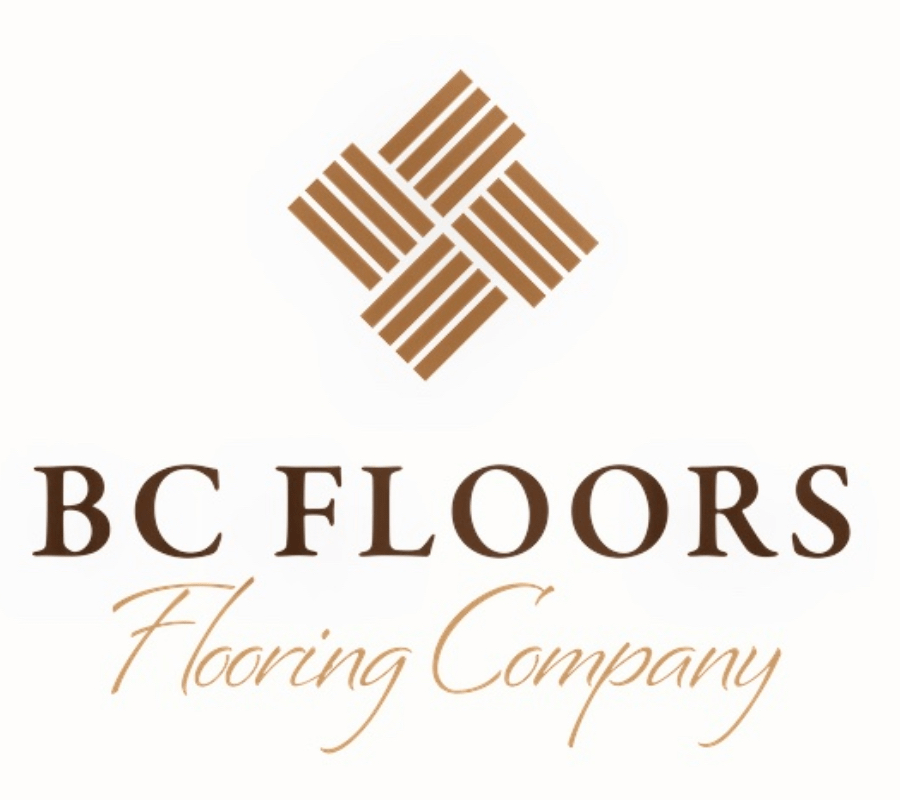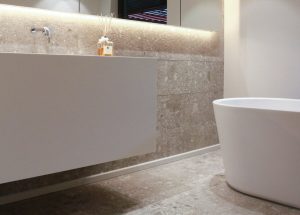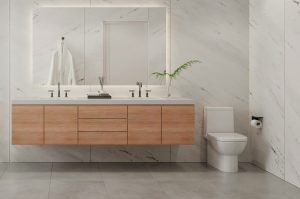Choosing the right flooring for your bathroom is an important decision that impacts both style and functionality. Bathrooms are among the most moisture-prone areas in a home, making a flooring choice crucial. The right material can prevent water damage and ensure long-lasting durability. Water-resistant flooring for bathrooms is an ideal solution, providing both durability and style.
What is Water-Resistant Flooring?
Water-resistant flooring is designed to withstand exposure to moisture without being damaged. Unlike traditional flooring options, water-resistant materials can repel water, preventing it from seeping through and causing issues such as warping, mold, or mildew. This type of flooring is particularly suitable for areas in the home that frequently come into contact with water, such as bathrooms, kitchens, and laundry rooms.
Water-resistant flooring often features a protective layer that shields the core material from water. This layer acts as a barrier, ensuring that any spills or splashes remain on the surface, allowing you to easily wipe them away. Many water-resistant floors also have enhanced sealing along their seams to prevent water penetration, making them an optimal choice for wet environments.
Another key aspect of water-resistant flooring is its ability to maintain its appearance despite frequent exposure to moisture. This durability ensures that your bathroom remains stylish and functional for years to come, without the need for constant maintenance or replacement.
Importance of Water-Resistant Flooring in Bathrooms
The bathroom is a high-moisture area where water exposure is inevitable, making water-resistant flooring a crucial consideration. Without proper flooring, water can seep into the subfloor, leading to structural damage that can be costly and time-consuming to repair. Water-resistant flooring helps protect against such damage by providing a barrier that keeps moisture at bay.
In addition to preventing structural issues, water-resistant flooring also plays a vital role in maintaining a hygienic bathroom environment. Moisture can lead to the growth of mold and mildew, which can not only damage your home but also pose health risks to you and your family. By choosing water-resistant flooring, you can minimize these risks and ensure a healthier living space.
Moreover, water-resistant flooring options often come with slip-resistant surfaces, which are essential for bathroom safety. Bathrooms can become slippery when wet, increasing the risk of falls and injuries. A slip-resistant floor can provide an extra layer of safety, making the bathroom a safer place for everyone, especially young children and the elderly.
Types of Water-Resistant Flooring Options
When selecting water-resistant flooring for your bathroom, it’s important to consider the various options available. Each type offers unique benefits, so understanding the differences can help you make an informed decision that meets your needs.
Vinyl Flooring
- Vinyl flooring is a popular choice due to its affordability and versatility. It comes in a wide range of styles, including planks, tiles, and sheets, allowing you to achieve the look you desire.
- This type of flooring is not only water-resistant but also easy to install and maintain, making it ideal for busy households.
- Luxury vinyl planks (LVP) and tiles (LVT) are particularly favored for their realistic appearance, mimicking the look of wood or stone without the associated maintenance concerns.
Ceramic and Porcelain Tiles
- Known for their durability, ceramic, and porcelain tiles are excellent water-resistant options for bathrooms.
- These tiles are available in various sizes, colors, and textures, providing endless design possibilities.
- Their dense, non-porous nature makes them resistant to water absorption, and they are also easy to clean and maintain.
Laminate Flooring
- While traditional laminate is not water-resistant, newer products with enhanced water-resistant technology are available.
- These laminates offer the look of wood with added moisture protection, making them suitable for bathroom use.
- When selecting laminate, ensure that it is specifically designed for moisture-prone areas to avoid potential issues.
Key Features to Look for in Water-Resistant Flooring
When selecting water-resistant flooring for your bathroom, there are several key features to consider, ensuring you make the best choice for your space.
- Moisture Resistance: The primary feature to look for is the level of moisture resistance. Check for products that have a high level of water repellence, ensuring they can withstand frequent exposure to water without damage.
- Durability: Since bathrooms are high-traffic areas, durability is essential. Choose flooring that can withstand wear and tear while maintaining its appearance over time.
- Ease of Maintenance: Consider how easy the flooring is to clean and maintain. Low-maintenance options will save you time and effort in the long run, making them a practical choice for busy households.
- Aesthetic Appeal: Your bathroom should be a reflection of your personal style. Select flooring that complements your design vision and enhances the overall look of your space.
- Safety Features: Safety is paramount in the bathroom, so look for flooring that offers slip-resistant surfaces to reduce the risk of accidents.
Benefits of Installing Water-Resistant Flooring
Installing water-resistant flooring in your bathroom offers numerous benefits, enhancing both functionality and aesthetics. Here are some of the key advantages:
- Protection Against Water Damage: Water-resistant flooring provides a robust barrier against moisture, preventing water from penetrating the subfloor and causing damage. This protection extends the lifespan of your bathroom floor and reduces the risk of costly repairs.
- Improved Hygiene: By minimizing water absorption, water-resistant flooring helps prevent the growth of mold and mildew, contributing to a cleaner and healthier bathroom environment. This is especially important for families with allergies or respiratory issues.
- Long-Lasting Beauty: These flooring options are designed to withstand daily use while maintaining their appearance. Whether you prefer the look of wood, stone, or tile, water-resistant flooring retains its beauty over time, enhancing the overall aesthetic of your bathroom.
- Increased Home Value: Upgrading to water-resistant flooring can increase the value of your home. Potential buyers will appreciate the durability and low-maintenance benefits, making your property more attractive on the market.
Cost Considerations for Water-Resistant Flooring
When planning your bathroom renovation, it’s important to consider the cost of water-resistant flooring options. Prices can vary significantly based on materials, installation, and design preferences, so understanding these factors can help you budget effectively.
- Material Costs: The cost of water-resistant flooring materials varies widely. Vinyl and laminate are typically more affordable options, while ceramic and porcelain tiles may be more expensive. Consider the long-term investment and choose materials that fit both your budget and design preferences.
- Installation Costs: Installation costs can also vary based on the complexity of the job and the type of flooring selected. DIY installation is possible with materials like vinyl. However, tiles require professional installation for proper fitting and sealing.
- Maintenance Costs: Water-resistant flooring needs less maintenance than traditional options. However, consider costs for cleaning supplies or occasional professional cleaning.
- Warranty and Longevity: Evaluate the warranty offered with your chosen flooring, as this can impact overall cost-effectiveness. A longer warranty may provide peace of mind, knowing that your investment is protected.
Summary
Selecting the right water-resistant flooring for your bathroom involves careful consideration of material options, costs, and desired features. When making your decision, weigh the benefits and costs associated with each type of flooring. Whether you prefer vinyl, tile, or modern laminates, choose what suits you best. Ensure your selection aligns with your lifestyle and design vision. Ultimately, investing in quality water-resistant flooring can enhance your bathroom’s longevity, safety, and overall appeal.


